It’s been called “trekking’s holy grail” — the longest, highest, and (in places) hardest alpine trail in the world...
The Great Himalaya Trail — the ‘GHT’ — traverses the full length of the Great Himalaya Range, all 2,400 kilometers. The actual walking trail is almost double that, or longer if you trek some or all of its alternatives. The GHT crosses five countries, from Namche Barwa in Tibet, through Bhutan, Nepal and India to Nanga Parbat in Pakistan, passing through some of the world’s most beautiful, wildest and remote mountain places.
The Nepal part of the GHT is the most complete (since 2003), the best mapped, most accessible and popular. And although Nepal is only 885 km long on a map, doing it afoot almost doubles that. In one go, you can walk it in reasonable comfort in around 160 days, from Kangchenjunga west to Api-Saipal Himal (Humla).
For shorter bites, the Nepal GHT is conveniently broken down and mapped in ten sections, each walkable in a few weeks or a month (or more) depending on your physical condition, the weather, and logistics (how far to go, how fast, how much to carry, how often to resupply). The most well-traveled sections are Mount Everest, Langtang & Helambu and the Annapurnas. The more ‘off the beaten track’ parts are Kangchenjunga, Makalu, Rolwaling, Manaslu & Ganesh Himals, Mustang, Dolpo & Mugu, and the Far-West.
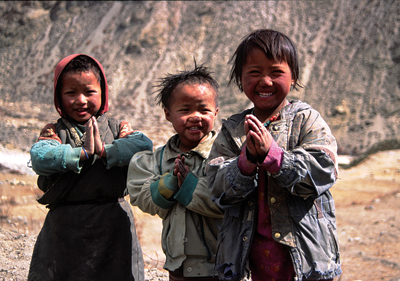
Parts of India’s Arunachal Pradesh, Bhutan, Sikkim, and most of northwest India are also open.
To prepare for the GHT, Robin Boustead advises doing some homework. Robin is an Australian who has been trekking the Himalaya for over two decades. He’s a modern GHT pioneer who promotes it as his personal mission. He knows the GHT better than anyone else. “As it’s a trail network,” he explained in a recent interview, “it can be as easy or as hard as you like, from a 5-day jolly to a 5-month epic.” Check out the GHT website and read the guidebook. Talk to outfitters and other trekkers. Bone up on the history of Himalayan exploration, and for that we’ve included some early explorers’ tales below.
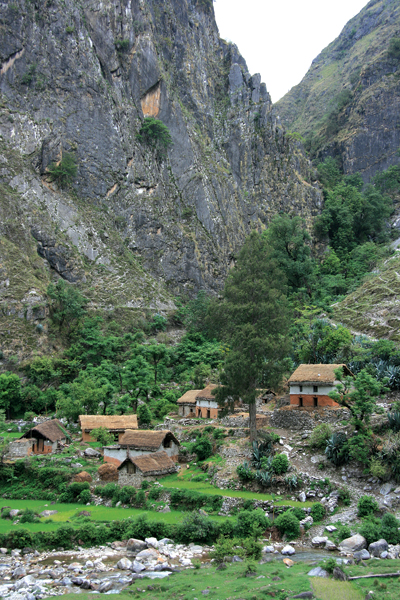 Choices
Choices
For planning, there are choices of where and how to trek, even within a short section. You can go high, pass-to-pass, amongst the peaks or you can trek lower down, village-to-village, on one of the “green” or “cultural” GHT trails along the hills and valleys. In the Dolpo and Mugu section, for example, the high track crosses Shey Phoksundo National Park over Yala La and Chyargo La, two passes above 5,000 meters near the Tibet border. The parallel cultural trail, some 35 km south, follows a low river valley across foothills ranging mostly well under 4,000 meters into the upper Bheri river valley. A third option between them links the high and low routes over the 5,115 m Kagmara La (‘Dead Raven’ Pass). Each route has its own charms and challenges (and dead ravens?).
Be sure to bring your digital camera, says Boustead, and spare media cards and batteries. But he cautions trekkers to “Only carry something you can afford to smash?” Good advice. The photography is spectacular, but a fall on the trail or a sticky shutter can spell disaster, so carry a spare small digital camera, just in case.
Because trekking involves risk, be prepared and be safe. At the same time, respect local cultures and traditions, and be both watchful and sensitive to the environment. The ‘Great Himalayan Trail Code’, championed by Boustead and the GHT Alliance, is your guide to an appropriate mindset. The GHT Alliance is a small group of experts who work together to formally promote the trail, encourage trek tourism, and bring economic benefits to local communities (see box).
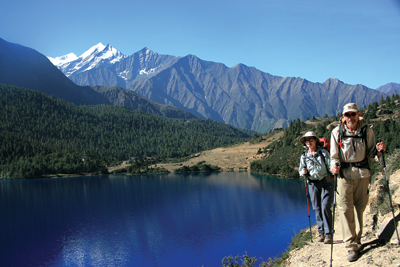
Trekking, says Boustead, is also about “immersing yourself in a range of cultures and geographies, appeasing the right gods, and forecasting the weather. It’s a completely different cognitive space. It’s like Aboriginal Dream Time — something to get your head around, explore and appreciate.”
“There’s a lot more to trekking than heights,” he says. The Tamang Heritage Trail, for example, starts a day west of Kathmandu in the Ganesh Himal section. It’s a great 10-day cultural excursion through rhododendron forests, with great mountain views, home stays, and “all the folk tales and songs, myths and legends, gods and spirits for that extra bit of appreciation.”
GHT Alliance
The GHT Alliance is a network of organizations and individuals who have helped establish and promote the Great Himalaya Trail. Alliance members represent trekking agencies, development organizations, and the private sector. They encourage sustainable and responsible tourism initiatives that favor ‘good practice’ and community development. The goal/purpose of GHT Alliance is to ensure that communities along the route get economic as well as ecological benefits from the route and from expanded tourism. A secondary goal of GHT is to ensure that tourism benefits (and environmental costs) get diversified from the main tourist routes and help other communities. One original concept was along the lines of a ‘greenway’ or ecological corridor throughout the Himalaya that would promote “green” or ecologically responsible growth along with economic development. The GHT Alliance can help ensure that both the ecological and economic benefits accrue, by providing technical guidance and mentoring as necessary.” (Brian Peniston, The Mountain Institute, Kathmandu)
The Alliance promotes a vocational training and skills programs to create long-term professional careers in the outdoor industry for local staff, adhering to the standards for guides advocated by the International Mountaineering and Climbing Federation. The goal is to promote career paths for those who are passionate about the Himalaya’s flora and fauna, traditions and cultures.
The Alliance also promotes a community action programs to provide guidance and direction to local communities who want to sustainably and responsibly benefit from tourism. These programs are essential to improving quality of life, reducing environmental pressures, and maximizing income generation.
The Alliance’s ‘Great Himalaya Trail Code’ encourages awareness among trekkers for community — respect cultures and traditions, benefit local communities commercially and socially, and adopt new customs (i.e., be sensitive and considerate); environment — tread softly, pack it in/pack it out, and conserve natural resources; and safety — beware of altitude sickness, be safe and be self-reliant.
For more on the GHT Alliance, see www.thegreathimalayatrail.org > GHT Alliance.
Robin Boustead
Robin Boustead is almost synonymous with the Great Himalaya Trail as its most avid and visible promoter. In a recent interview, however, he stated categorically: “I certainly don’t see it either as ‘my trail’ or, in fact, a formal trail at all.” Rather, “It’s more a network of routes that people can use to design their own adventure and that will bring the benefits of tourism to communities that really need some help,” he said.
Robin’s passion for the outdoors and mountains began in the UK, when he was in Scouts and sometimes went to summer adventure camps. “It was easy to fall in love with the outdoors,” he says. Later, at the university, he enjoyed sailing, walking and climbing. At the age of 24 he set off to travel around the world. “I went trekking in Sikkim,” he says, “and the Himalaya overwhelmed me. It was there I met Judy who later became my wife. Since 1993 we’ve spent as much time as possible in the Himalaya trekking and travelling. Now it’s almost a fulltime job!”
When asked which part of the GHT fascinates him the most, he replied: “All of it! ...I love revisiting any route, especially at different times of year. The Himalaya are constantly changing and..., well, I just don’t get enough of them!”
Robin’s book, Nepal Trekking and The Great Himalaya Trail: A Route and Planning Guide, is reviewed on page 44).
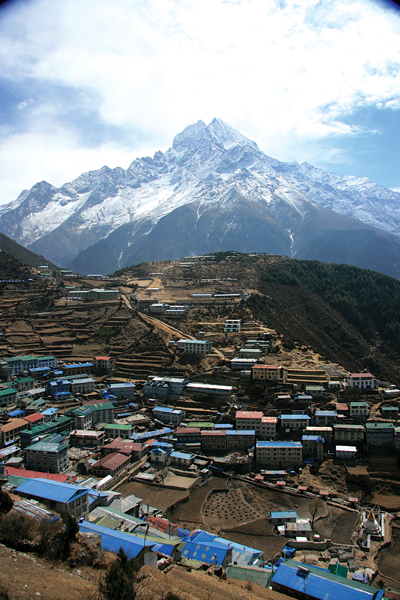 Origins
Origins
The idea of a Great Himalaya Trail has been around awhile, but only recently was it fully mapped and christened. During the early 2000s, serious discussions were held about developing an economically strong tourism-promotion program along such a trail, or trails. A variety of interested parties were involved, including national tourism development and travel agency folks, avid trekkers like Boustead, staff and consultants of The Mountain Institute, and aid agencies including The Netherlands’ SNV and the UN. Soon, the GHT Alliance was formed and the GHT was born. The name ‘Great Himalaya Trail’ came from a trek-tourism development proposal.
Once it was formally named, Robin Boustead set off to trek and document it. It was a remarkable endeavor. But Boustead wasn’t the first to walk vast parts of the trail. Other adventurous folks preceded him. And a few have done it on the run.
Early Walks and Runs
In 1980, Shiro Shirahata, one of the world’s great mountain photographers, was the first to cross Nepal high up, east to west. Then he published a remarkable large format picture book. That same year, an Indian army team set out from Arunchal Pradesh and in the course of several seasons trekked relay fashion along a high mountain route as far west as Ladakh in the Karakorum.
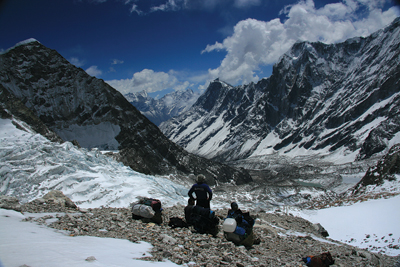
In 1981, Peter Hillary (son of Sir Edmund), Graeme Dingle and Chhewang Tashi trekked from Kangchenjunga to K2 in Pakistan. They were followed in 1982-83 by Arlene Blum and Hugh Swift who walked Bhutan to Ladakh in nine months. Members of the British Women’s Trans-Himalayan Expedition also walked it in 1983, west from Sikkim.
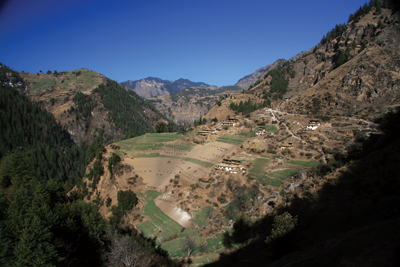
The first runners showed up in 1983, the Crane brothers, Richard and Adrian, who jogged from Kangchenjunga to Nanga Parbat in just under 100 days. They went super-light: “One rucksack, one sleeping bag, one set of clothes, one pair of shoes,” they wrote, “and shared minimal supplies: map, diaries, camera, penknife, water jar and two plastic teaspoons. No guides, no porters, no shelter, no food, no water. And we would be running.” Conclusion: “Looked at logically,” they wrote, “the idea was preposterous.” But they did it anyway.
In 1990, Sorrell Wilby and Chris Ciantar walked east from Pakistan to Arunachal Pradesh. And in 1997, Alexandre Poussin and Sylvain Tesson walked west from Bhutan to Tajikistan.
Then, another runner, Rosie Swale-Pope, breezed by in 2003, doing the length of Nepal in 68 days, raising money for the charity Nepal Trust. In 2007, Gillian Holdsworth and guide Sonam Sherpa, walked it to raise money for another charity, the Britain Nepal Medical Trust.
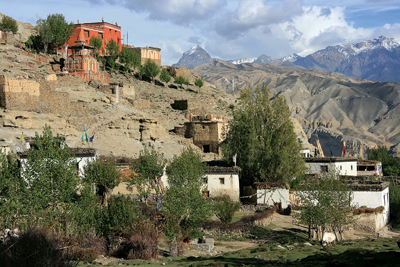
Robin Boustead set out in 2008-09, and over two seasons he documented the full length of the Nepal GHT, identifying main routes and alternatives using GPS technology. In a word, he put the Great Himalayan Trail on the map.
The most recent run of the GHT was the most amazing, time-wise. In the fall of 2010 Sean Burch dashed the length of Nepal in a grueling 49 days, assisted by the Nepal Trust and a local support crew. His GHT World Record Expedition called it “The trail to rule them all.”
Earlier this year, 2011, in February, Robin Boustead set out to walk and blog the GHT once again, at the head of a World Expeditions guided trek.
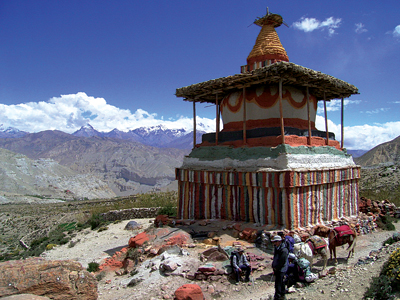
The most astonishing GHT event of 2011 was by Justin Lichter (trail name ‘Pepper’) and Shawn Forry (‘Trauma’), walking “8000 m East to 8000 m West”, Kanchenjunga to Nanga Parbat, the 8,000 m peaks that mark the start and end of their jaunt. They finished phase one, all of Nepal, in record time, 57 days (47 of them walking), carrying heavy packs and relying on pre-arranged food caches. “The last 14 days [were] unbelievable and also amazingly difficult,” Lichter blogged on May 28, after reaching Simikot in far west Humla District. “Probably one of the most difficult sections of hiking I have ever done,” he said. In the last ten days, they crossed ten passes above 5,000 meters. A truly serious accomplishment, cruising along at a near runner’s pace, warp speed.
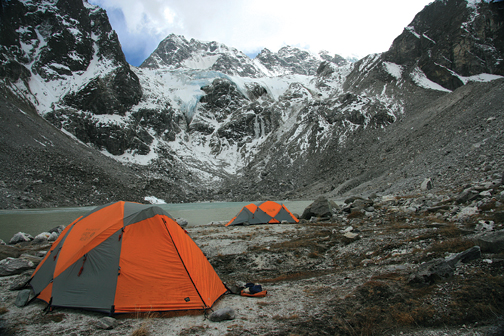
The Start of Himalayan “Trekking”
While hiking up, down, through and across the Himalaya is ages old (at normal speeds), calling it ‘trekking’ is relatively new (from trekken, Afrikaans for a long arduous journey). Before modern trekking for pleasure, countless pilgrims, merchants, explorers, spies, and missionaries criss-crossed the mountains. The Hindu Vedas describe pilgrimage destinations dating to 300 BC, and some early trans-Himalayan commerce was probably on before that. There’s a distinction, however, between crossing the Himalaya on a north-south axis and doing the GHT as an east-west traverse along the length of the massif.
The modern era of trekking in Nepal began in 1965 when Colonel James O.M. ‘Jimmy’ Roberts founded Mountain Travel, Nepal’s first trekking agency. Roberts was a retired Gurkha officer, former military attaché to Nepal, and liaison to the 1963 American Mount Everest Expedition. He catered group treks with Sherpa guides and cooks, tents and amenities, and porters to carry the gear. His model is still popular.
Today’s GHT tripper can choose a group style expedition with all the trimmings, or go ‘teahouse style’ putting up nights in guesthouses, or do a home-stay trek on one of the GHT Cultural Trails, or hike independently without a guide. It depends on personal style and inclinations, though going entirely alone is not advised.

Stories from Earlier Explorers
Well before modern trek-tourism and long distance walks and runs, many stalwart folks explored the Himalaya, then wrote up their remarkable journeys for posterity. Here are a few excerpts, from a much larger list of stories.
In 1624 AD, for example, two Portuguese Jesuits, Fr Antony Andrade and Br Manuel Marquez, trekked through the north Indian Himalaya and on into westerm Tibet on a mission. Andrade’s journal is probably the earliest foreign description of Himalayan trekking. After leaving the north Indian plains (and disguised as pilgrims), he wrote: “We then began to climb those lofty mountains, which have not their like perhaps on the surface of the globe. In some places the passage ...is so narrow, that we could only just put one foot before the other, ...clinging to the rocks with our hands, and at a single false step we should have been dashed to pieces.”
Some descents were “still more perilous, for one knows not what to cling to. We were several times obliged to turn round and go backwards... and to step with the greatest possible caution; but we had constantly before our eyes the example of pagans [Hindu pilgrims] who were braving all these difficulties to honour their gods, many even so advanced in years that they could hardly drag themselves along...
And they sometimes experienced cold “so severe, that we had lost all feeling in various parts of the body, — principally the hands, feet, and face.”
Two centuries later, in 1815, James Baillie Fraser, 15th Laird of Reelig (Scotland), merchant and artist, joined his brother William, a political agent with the British Army, on an arduous three-month journey across the Indian Himalaya northwest of Garhwal. At one point, Fraser describes enduring a storm of Himalayan proportions that “came down from the mountains [and] threatened to destroy our frail tent, and tear both it and ourselves to atoms, but its humbleness preserved it, and the gale blew over it; at others, the rain that fell cleared the sky, and opened to our view the mountain scenery, beautiful in varied tints, refreshed by moisture, and rising and retiring alternately, till lost in the mellow blue of distance near the plains.”
The geography, he wrote, was “a confused and chaotic assemblage of most rugged mountains, huddled into masses and peaks, and running into ridges which defy arrangement, and it is only by attentive observation that they can be traced to one or other of the mighty piles that compose the snowy range.”
In 1819, William Moorcroft and George Trebeck traveled with a large entourage across the north Indian Himals, posing as merchants. At one village, Moorcroft wrote, “On the arrival of the first of our party a general panic prevailed... A report had spread that the Feringis, or Europeans, were approaching... to occupy and devastate the country, the precursors of the invading host.” The tumult soon calmed down and “their terrors were allayed, and gradually confidence succeeded to apprehension. They had never yet beheld a European, and curiosity brought crowd after crowd to look at the Sahib log [log is Hindi for ‘people’] until it was dark. Night set in with a thunder-storm, and in the darkness we were disturbed by the singular howling of the hyaenas [or jackals?], who approached our encampment and are said to be common here.”
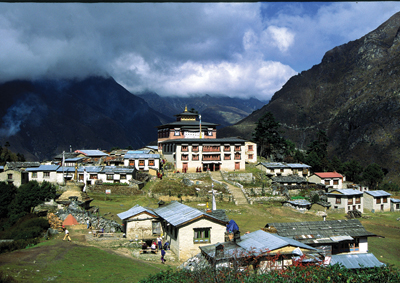 In 1847-51, the English botanist Joseph Dalton Hooker launched a plant collecting expedition to northeast Nepal. His descriptions of the flora take up much of his daily journal — extensive, detailed and technical. But he was equally effusive about the geography and local cultures. The mountains especially impressed him. On awakening one morning to a clear view of Kangchenjunga, he wrote: “the transparency of the atmosphere rendered this view one of astonishing grandeur. Kinchinjunga [sic] bore nearly due north, a dazzling mass of snowy peaks, intersected by blue glaciers, which gleamed in the slanting rays of the rising sun, like aquamarines set in frosted silver.”
In 1847-51, the English botanist Joseph Dalton Hooker launched a plant collecting expedition to northeast Nepal. His descriptions of the flora take up much of his daily journal — extensive, detailed and technical. But he was equally effusive about the geography and local cultures. The mountains especially impressed him. On awakening one morning to a clear view of Kangchenjunga, he wrote: “the transparency of the atmosphere rendered this view one of astonishing grandeur. Kinchinjunga [sic] bore nearly due north, a dazzling mass of snowy peaks, intersected by blue glaciers, which gleamed in the slanting rays of the rising sun, like aquamarines set in frosted silver.”
The closer to Tibet he got, Hooker noted that “A change in the population accompanies that in the natural features of the country, Tibetans replacing the Nepalese who inhabit the lower region. I daily passed parties of ten or a dozen Tibetans, on their way to Mywa Guola, laden with salt; several families of these wild, black, and uncouth-looking people generally travelling together...”
Then comes one of Hooker’s most poignant passages describing a scene that modern GHT trekkers (if lucky) still might see on the trail: “These groups of Tibetans are singularly picturesque, from the variety of their parti-coloured dresses, and their odd appearance. First comes a middle-aged man or woman, driving a little silky black yak, grunting under his load of 260 lbs. of salt, besides pots, pans, and kettles, stools, churn, and bamboo vessels, keeping up a constant rattle; and perhaps, buried amongst all, a rosy-cheeked and lipped baby, sucking a lump of cheese-curd. The main body follow in due order, and you are soon entangled amidst sheep and goats, each with its two little bags of salt; beside these stalks the huge, grave, bull-headed mastiff, loaded like the rest, his glorious bushy tail thrown over his back in a majestic sweep, and a thick collar of scarlet wool round his neck and shoulders, setting off his long silky coat to the best advantage; he is decidedly the noblest looking of the party, especially if a fine and pure black one, for they are often very ragged, dun-coloured, sorry beasts. He seems rather out of place, neither guarding nor keeping the party together, but he knows that neither yaks, sheep, nor goats, require his attention; all are perfectly tame, so he takes his share of work as salt-carrier by day, and watches by night as well. The children bring up the rear, laughing and chatting together; they, too, have their loads, even to the youngest that can walk alone.”
In 1899 a sprightly 54-year old Brit, Douglas W. Freshfield, accompanied by the celebrated Italian photographer, Vittorio Sella, accomplished a Himalayan ‘first’. They circumambulated Kangchenjunga. It took them seven weeks, and it is said that near the end, upon reaching Dzongri (Freshfield’s ‘Jongri’) in Sikkim they lit a great bonfire, and when the Governor of Bengal saw it from Darjeeling he ordered a military gun salute to be fired in the explorer’s honor.
Like Hooker before him, Freshfield kept detailed notes, painting great scenes in fine words. He thought Siniolchu, for example, was “the most superb triumph of mountain architecture and the most beautiful snow mountain in the world.” He also described the typical high forest traveler who “pushes on by a track half buried between the red twisted stems of tree-rhododendrons, hung with long waving lichens, until he emerges at last on open sky and the upper pastures — the alps of the Himalaya — fields of flowers, of gentians and edelweiss, of primulas and poppies, which blossom beneath the snowfields that encompass the ice-mailed and avalanche-fluted shoulders of the giants of the range.”
Some evenings he witnessed amazing sunsets, and alpenglow, with colors “tender and exquisitely graduated; pools of green and gold sky were ringed round with the ruddier tints of the melting vapours. We noticed more than once a peculiarity..., the false sunset in the East, where a glow... would show above the mountain tops, while zodiacal rays, or an appearance resembling them — thin bars of light — shot across the zenith, uniting what appeared as separate sources of illumination....”
On nights when it was too cold for prolonged star-gazing, “Silence fell on the camp, even the coolies’ tongues were hushed. The sound of an occasional avalanche from the cliffs of the Jonsong Peak rang from time to time through the stillness like a distant salute.”
Afterward, Freshfield wrote, “I slept fairly, but dreampt wildly...” A hard day on the GHT can do that to you!
A half century later, in 1949-50, H.W. ‘Bill’ Tilman received rare permission from Nepal to trek near Mount Everest from the south, to Helambu north of Kathmandu, and west past Ganesh Himal into the Annapurna region. He, too, demonstrated a talent for words. For example, while trekking under Ganesh Himal in the rain, he wrote: “After following a small but turbulent glacier stream for a short way we came at last to a lush meadow alive with sheep and goats, and, in my opinion, vastly improved by the presence of several mat shelters. Warding off the attacks of savage dogs..., we made for the nearest shelter, pushed aside the mat door and unceremoniously squeezed our dripping bodies round the fire.” There, “The shepherds plied us with cheese, tasting like dried milk that had somehow got wet, and cheered us with the news that eight days previously they had enjoyed a fine day.”(!)
And in 1956, the Tibetologist David Snellgrove made a remarkable seven month journey over hundreds of miles across west Nepal. Snellgrove and Pasang Khambache Sherpa trekked from Nepalganj up the Bheri river, then east across Dolpo, Mustang, Manang, upper Gorkha and Dhading Districts to Kathmandu. They were researching Tibetan culture, temple architecture, sacred statuary, and Buddhist frescoes. Snellgrove defined their trip as a pilgrimage in the simple Tibetan sense of ‘gnas-skor’ — ‘going around places’.
By the 1960s, Himalayan trekking — a kind of ‘going around places’ — was in full swing and Nepal was becoming a popular destination for adventure tourism. The Himalaya remains full of discovery as one of the most exotic and thrilling trek destinations on planet Earth. And, it’s there for you, with all its vagaries and high points, still much as the early explorers described them.
Read the guidebook, study the the maps, then lace up your boots, shoulder your pack, and we’ll look for you on the trail, or on your blog, or in your book!
To research the GHT see thegreathimalayatrail.org, along with maps from Himalayan Map House in Thamel (himalayan-maphouse.com), and Nepal Trekking and the Great Himalaya Trail: A Route & Planning Guide (Trailblazer Publications, 2011). See also worldexpeditions.com > Great Himalaya Trail, Robin Boustead’s blog at trekthegreathimalayatrail.com, seanburch.com for the story of his amazing 49 day run, justinlichter.com for more on the recent Lichter and Forry trek to Simikot, and ? the story at guardian.co.uk (11 March 2010) by Ed Douglas who first called the GHT “trekking’s holy grail.”
Quotation sources: R. & A. Crane, Running the Himalayas (1984); M. L’Abbe Huc, Christianity in China, Tartary and Thibet (1873); J.B. Fraser, Journal of a Tour through Part of the Snowy Range of the Himálá Mountains... (1820); H.H. Wilson, ed., (Moorcroft’s) Travels in the Himalayan Provinces of Hindustan and the Panjab... from 1819 to 1825 (1841); J.D. Hooker, Himalayan Journals (1855); D.W. Freshfield, Round Kangchenjunga (1903); H.W. Tilman, Nepal Himalaya (1952); and D. Snellgrove, Himalayan Pilgrimage (1961). See also S. Shirahata, Nepal Himalaya (1985); A. Blum, Breaking Trail (2005); M. Archer & T. Falk, India Revealed: The Art and Adventures of James and William Fraser 1801-35 (1989); and B. & P. Morrow, Footsteps in the Clouds: Kangchenjunga a Century Later (1999).
Don Messerschmidt, who has trekked and written about portions of the GHT in the past, is a contributing editor to ECS Nepal magazine. He thanks Robin Boustead (two interviews), GHT Alliance members Brian Peniston, Lisa Choegyal and Ian Wall, and the notes of Mac Odell and other Mountain Institute staff and consultants for help with the story. If any other remarkable GHT feats are missing, write to Don at don.editor@gmail.com.











